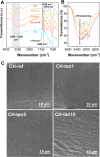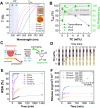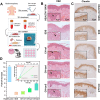Skin Barrier Restoration by Waste-Derived Multifunctional Adhesive Hydrogel Based on Tannin-Modified Chitosan
- PMID: 40388263
- PMCID: PMC12186222
- DOI: 10.1021/acsami.5c03066
Skin Barrier Restoration by Waste-Derived Multifunctional Adhesive Hydrogel Based on Tannin-Modified Chitosan
Abstract
The development of multifunctional materials that actively enhance the wound healing process is critically important in addressing clinical and public healthcare challenges. Here, we report a multifunctional hydrogel obtained through physical cross-linking of chitosan and wood tannins for active wound management. Tannins, as polyphenolic wood-waste derivatives, act both as multifunctional additives and cross-linking agents, resulting in a stable and highly swellable hydrogel (>2000%·mg-1). The dressing is produced in the form of a dry and rigid film for easy transportation. After swelling, the material exhibits adequate Young's modulus (∼7 MPa, comparable to the stratum corneum's stiffness), improved flexibility, and suitable adhesion strength to adapt to joint movements. Polyphenolic tannins also provide the material with high antioxidant activity against DPPH radicals (100% RSA), showing potential for preventing complications during the inflammation phase. Moreover, tannins can completely block skin-damaging UV light without significantly altering the material's transparency, thus allowing constant visual wound monitoring. Wound healing investigations on abdominoplasty-derived skin demonstrated that tannins enhance the normal skin barrier restoration process, thereby facilitating the transition toward wound regeneration. This work offers a sustainable strategy for valorizing agri-food waste in a fully biobased material to address active wound management.
Keywords: active wound dressings; chitosan; polyphenols; skin barrier restoration; tannins; waste valorization.
Figures






Similar articles
-
Preparation of ″Five-in-One″ Chitosan Hydrogel for Infectious Wound Repair.ACS Appl Mater Interfaces. 2025 Aug 27;17(34):48000-48016. doi: 10.1021/acsami.5c10994. Epub 2025 Aug 14. ACS Appl Mater Interfaces. 2025. PMID: 40810450
-
Block cationic copolymer/quaternary ammonium chitosan-based composite antibacterial hydrogel dressings with NIR photothermal effects for bacteria-infected wound healing.Int J Biol Macromol. 2025 Feb;288:138716. doi: 10.1016/j.ijbiomac.2024.138716. Epub 2024 Dec 12. Int J Biol Macromol. 2025. PMID: 39672433
-
A photothermal-enhanced thermoelectric nanosheet incorporated with zwitterionic hydrogels for wound repair and bioelectronics.Acta Biomater. 2025 Jun 15;200:610-628. doi: 10.1016/j.actbio.2025.05.033. Epub 2025 May 12. Acta Biomater. 2025. PMID: 40368059
-
Hydrogel dressings for venous leg ulcers.Cochrane Database Syst Rev. 2022 Aug 5;8(8):CD010738. doi: 10.1002/14651858.CD010738.pub2. Cochrane Database Syst Rev. 2022. PMID: 35930364 Free PMC article.
-
Dressings and topical agents for the management of open wounds after surgical treatment for sacrococcygeal pilonidal sinus.Cochrane Database Syst Rev. 2022 May 20;5(5):CD013439. doi: 10.1002/14651858.CD013439.pub2. Cochrane Database Syst Rev. 2022. PMID: 35593897 Free PMC article.
Cited by
-
Innovative Biobased Active Composites of Cellulose Acetate Propionate with Tween 80 and Cinnamic Acid for Blueberry Preservation.Polymers (Basel). 2025 Jul 29;17(15):2072. doi: 10.3390/polym17152072. Polymers (Basel). 2025. PMID: 40808120 Free PMC article.
References
MeSH terms
Substances
LinkOut - more resources
Full Text Sources

